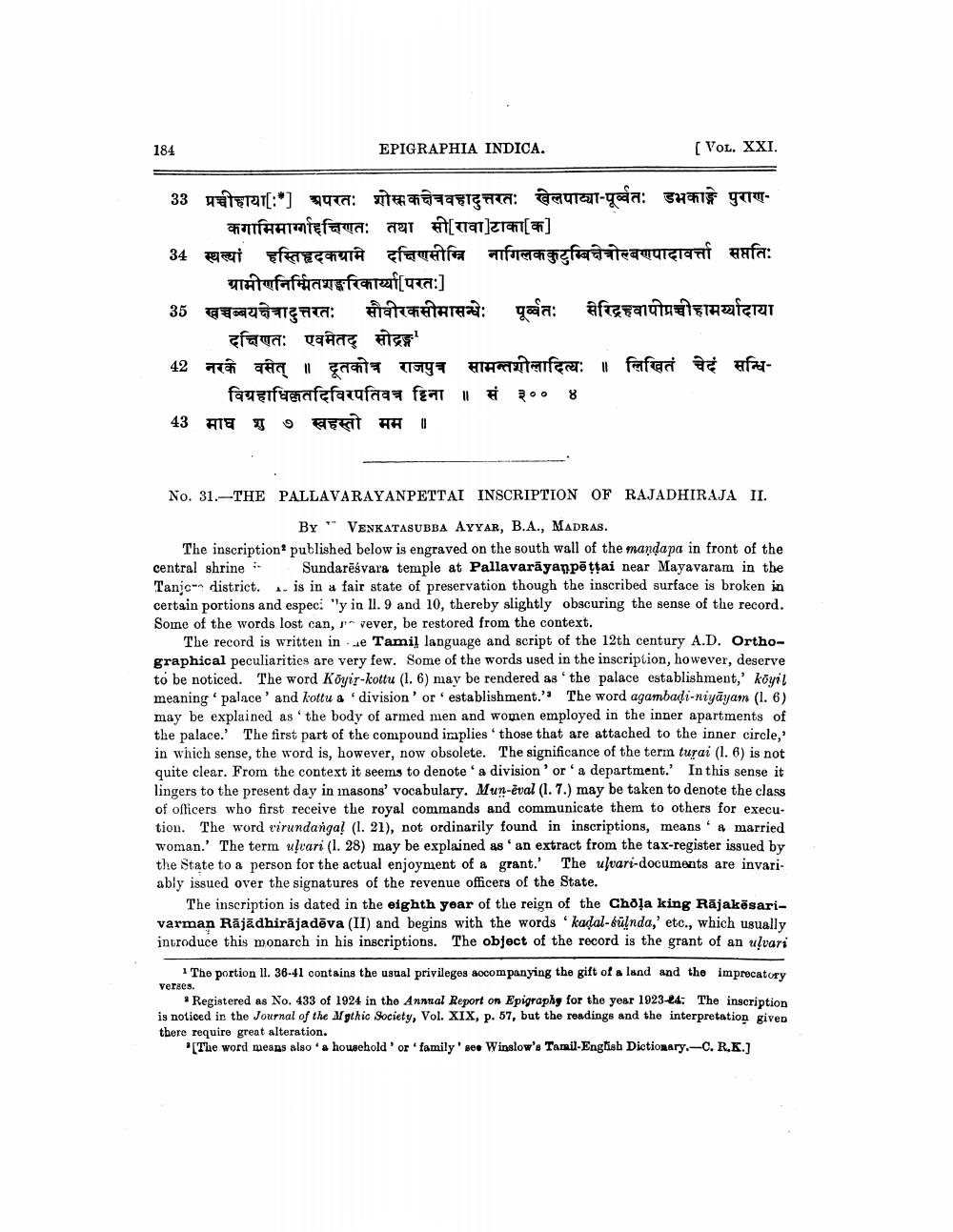________________
184
EPIGRAPHIA INDICA.
[Vol. XXI.
प्रच्चीहाया[:*] अपरत: शोस्म कक्षेत्रवहादुत्तरत: खेलपाट्या-पूर्वत: डभकाङ्गे पुराण
HAMIEfatua: [771]7141[*] 34 स्थल्यां हस्तिहृदकग्रामे दक्षिणसीनि नागिलककुटुम्बिक्षेत्रोल्बणपादावर्त्ता सप्ततिः
watafafanefice[axa:] 35 खच्चब्बयक्षेत्रादुत्तरत: सौवीरकसीमासन्धेः पूर्वत: सेरिद्रहवापोपच्चीहाम-दाया
graua: VÄRE EIGE 42 नरके वसेत् ॥ दूतकोत्र राजपुत्र सामन्तशीलादित्यः ॥ लिखितं चेदं सन्धि
विग्रहाधिकृतदिविरपतिवत्र हिना ॥ सं ३०० ४ 43 माघ शु . स्वहस्तो मम ।
No. 31.--THE PALLAVARAYANPETTAI INSCRIPTION OF RAJADHIRAJA II.
BY VENKATASUBBA AYYAR, B.A., MADRAS. The inscription published below is engraved on the south wall of the mandapa in front of the central shrine - Sundarēsvara temple at Pallavarāyanpēţtai near Mayavaram in the Tanjc district. is in a fair state of preservation though the inscribed surface is broken in certain portions and especi "y in II. 9 and 10, thereby slightly obscuring the sense of the record. Some of the words lost can, vever, be restored from the context.
The record is written in de Tamil language and script of the 12th century A.D. Orthographical peculiarities are very few. Some of the words used in the inscription, however, deserve to be noticed. The word Köyir-kottu (1.6) may be rendered as the palace establishment,' köyil meaning palace' and kottu a division' or establishment.'' The word agambadi-niyāyam (1.6) may be explained as the body of armed men and women employed in the inner apartments of the palace. The first part of the compound implies those that are attached to the inner circle, in which sense, the word is, however, now obsolete. The significance of the term turai (1. 6) is not quite clear. From the context it seems to denote' a division' or 'a department.' In this sense it lingers to the present day in inasons' vocabulary. Mun-eval (1. 7.) may be taken to denote the class of officers who first receive the royal commands and communicate them to others for execution. The word virundanga! (1. 21), not ordinarily found in inscriptions, means & married woman.' The term uscari (1. 28) may be explained as an extract from the tax-register issued by the State to a person for the actual enjoyment of a grant.' The usvari-documents are invariably issued over the signatures of the revenue officers of the State.
The inscription is dated in the eighth year of the reign of the Chola king Räjakösarivarman Rājādhirājadēva (II) and begins with the words 'kadal-cülnda,' etc., which usually introduce this monarch in his inscriptions. The object of the record is the grant of an ulvari
1 The portion 11. 36-41 contains the usual privileges aocompanying the gift of a land and the improcatory verses.
* Registered as No. 433 of 1924 in the Annual Report on Epigraphy for the year 1923-24: The inscription is noticed in the Journal of the Mythic Society, Vol. XIX, p. 57, but the readings and the interpretation given there require great alteration.
The word means also a household' or family' see Winslow's Tamil-English Dictionary-C. R.K.)




